If you have trouble using perishable food before it spoils, you’re certainly not alone. Approximately 133 billion pounds of food waste is generated in the U.S. each year, and a whopping 39 percent of Americans say they feel guilty about wasting food.
According to the Natural Resources Defense Council, about two-thirds of household food waste is due to spoilage. So, to help you cut back on wasted food (and inflated grocery bills), Earth911 compiled this list of creative kitchen tools to help you keep food fresher, longer.
And if you’re on a tight budget or would rather not buy new, we’ve also provided handy DIY alternatives for each of these fun, food-saving gadgets.
This article contains affiliate links that help fund our Recycling Directory, the most comprehensive in North America. If you purchase an item through one of these links, we will receive a small commission.
1. Vegetable Keep Sacks
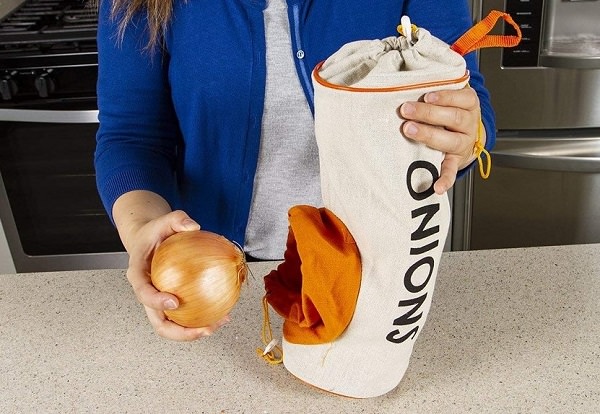
Did you know that storing some vegetables — such as potatoes, onions, and garlic — in the refrigerator can actually make them spoil faster? Most root vegetables keep longest in a dry place that’s cool but not as cold as the average fridge.
Since most of us don’t have a root cellar, the best way to give root veggies a longer shelf-life is to keep them cool and away from light — to help prevent sprouting.
Evriholder’s keep sacks for potato, onion, and garlic make it easy to keep your veggies in the dark. Simply add veggies at the top, and remove them from the bottom when they’re ready to use.
DIY Alternative: If you’d rather not buy a new item to preserve your veggies, simply store onions and potatoes in paper or fabric bags in a cupboard or pantry. Skip the plastic bags; paper and fabric are more breathable, which helps prevent spoilage.
Tip: Don’t store potatoes and onions together. As potatoes ripen, they give off moisture and gases that cause onions to spoil more rapidly.
2. Cheese Vault
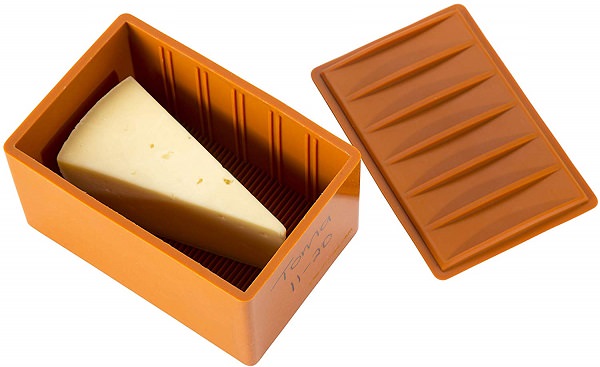
Cheese is one of those foods that’s often difficult to keep fresh. If your cheddar, Gouda, and Parmesan cheeses aren’t developing mold, they’re often becoming mushy or drying out, which is equally unappetizing. Experts will steer you away from plastic wrap, which can suffocate your cheese and transfer an unpleasant plastic flavor.
The Cheese Vault by CapaBunga allows cheese to breathe and prevents moisture buildup, keeping your cheese fresh and tasty longer.
Made of reusable, BPA-free silicone, the Cheese Vault makes it easy to keep track of how long you’ve had your cheese. Write the cheese name and date on the label end with a ballpoint pen. It easily wipes off to label your next cheese.
DIY Alternative: To help preserve cheese without a buying a new gadget, wrap cheese securely in wax paper before storing it in the refrigerator. This method allows the cheese to breathe without letting in excess moisture or odors from your fridge.
3. Pop Containers
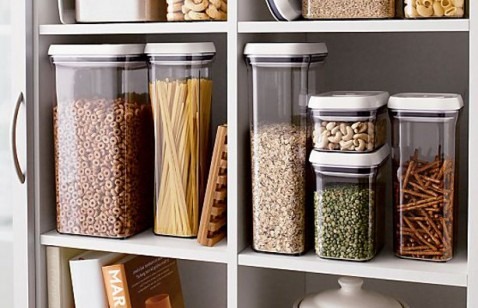
Storing half-empty bags of cereal, pretzels, and other dry foods in your pantry often leaves them stale, tasteless, and — let’s just say it — pretty gross.
Avoid tossing stale snacks, pasta, and other pantry picks by transferring dry foods into air-tight containers after you’ve opened the original packaging.
These ‘Pop’ Containers from OXO are available in 11 different stackable shapes and sizes for easy pantry organization. The innovative pop-button mechanism creates an airtight seal and doubles as a handle.
DIY Alternative: To avoid buying new, pick up a few Mason jars from your local thrift shop for air-tight pantry storage. Or, rescue a few large glass jars, such as those used to package pickles and pasta sauce, from your recycling bin for reuse as storage solutions.
4. Bread Preserver Box
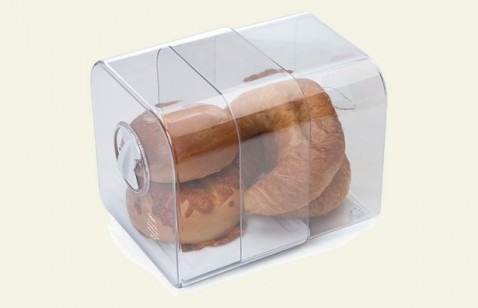
There’s nothing quite like freshly-baked bread. But how do you keep your bread, bagels, rolls, and other baked goods fresh longer?
Depending on where you call home, the air in your kitchen can dry out your bread, causing it to become stale. In more humid climates, baked goods may become too moist and begin developing mold earlier than usual.
So, what’s a greenie to do? Contrary to popular belief, storing bread in the refrigerator actually makes it spoil more quickly. The interior of your fridge draws moisture out of baked goods, causing them to go stale. Your best bet is to store bread on the kitchen counter using a container that regulates airflow.
This Expandable Bread Keeper from Progressive expands up to 11 inches to accommodate most loaf sizes. It features an adjustable vent that regulates airflow and keeps baked goods fresh.
DIY Alternative: Wrap your baked goods in a fabric bag, tea towel, or old pillowcase and store it on the counter in an airtight container, like a repurposed popcorn tin. If you’re not going to eat your bread within a few days, wrap it and freeze it before it starts to decline in quality.
5. Fresh Herb Preserver

Just like fresh-cut flowers, fresh herbs stored with a source of water will retain their flavor and texture for longer than if stored loose in the refrigerator or on a countertop.
The suspended slotted tray in the AIR+COOK Herb Preserver allows herbs to stand upright and comfortably spaced with their stems immersed in water for hydration. For convenience, the Herb Preserver also fits snugly inside your refrigerator door.
DIY Alternative: Soft herbs such as parsley, basil, and cilantro stay fresh longest when stored on the counter in a glass with about an inch of water. Trim the stems before you put your herbs in the glass. For a longer shelf-life, wrap non-leafy herbs like rosemary, sage, and thyme in a moistened towel and store in a reusable shopping bag in the refrigerator.
6. Garlic Keeper
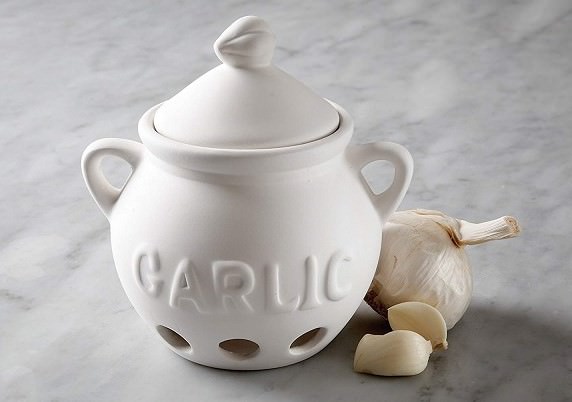
Much like vampires, garlic prefers the darkness. Both light and moisture can cause mold to grow. And refrigerating garlic can cause it to sprout and taste bitter. For best results, store garlic in a dry, dark place with plenty of air circulation.
To take the guesswork out of storing your garlic, check out this nifty Garlic Keeper, which keeps your tasty bulbs in the dark for maximum freshness. Specialized holes allow for the proper ventilation garlic needs to stay fresh, eliminating unwanted oxidation and moisture.
DIY Alternative: To mimic the effect of this cool Garlic Keeper without buying a brand-new item, store your garlic in a dark location with good air circulation, such as inside your pantry.
Tip: Don’t store garlic in a sealed container. Fresh bulbs can be stored in a wire or mesh basket or even a paper bag. Just make sure your bulbs are away from sunlight and getting plenty of air for a fresh bite for weeks to come.
7. Onion Saver
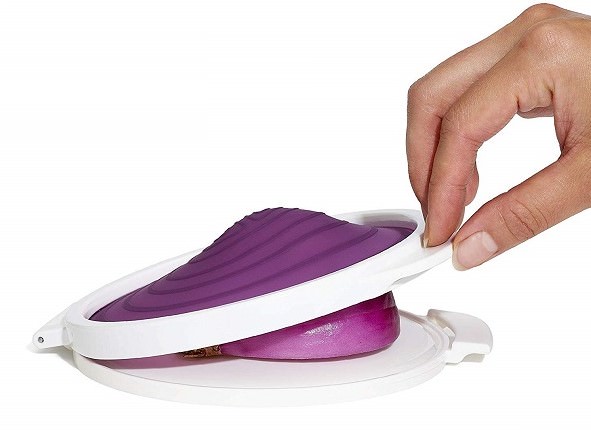
Figuring out how to store cut onions properly is a common kitchen conundrum. Sure, you want to save that unused onion from last night’s dinner. But onions perish quickly after they’ve been cut, and it can often be tricky to remember to use them before they spoil.
Once you’ve cut an onion, you should always transfer it from pantry storage to the refrigerator to keep it fresh. Too much air can cause exposed onion to oxidize, leading to discoloration and a not-so-tasty flavor, so you’ll also want to opt for an air-tight container for storage.
This Cut & Keep Onion Saver by OXO has a lid of stretchy silicone to adjust to the size of your cut onion. It snaps shut to seal, so you can put the onion in your fridge without causing a stinky situation. This cute Onion Saver is great for conserving fridge space, and it also makes that cut onion stand out from the rest of the stuff in your fridge, reminding you to use it more quickly.
DIY Alternative: If you’d rather not buy new, any air-tight storage container will accomplish the same job.
8. Avocado Holder
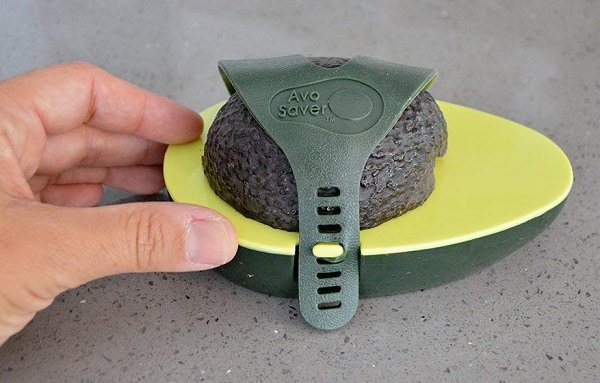
After you’ve cut an avocado in half, how do you save the other half from turning brown without using plastic wrap?
The BPA-free plastic of the Evriholder Avo Saver covers the cut edge of an avocado half, pit and all. A durable rubber strap holds the Avo Saver securely to the avocado, reducing air exposure, slowing the oxidation process, and keeping the fruit from turning brown too quickly. Your avocado half is even secure enough strapped into the Avo Saver that you can carry it in your lunch bag or picnic basket without worry.
DIY Alternative: Place a halved red onion onion in an airtight container with your cut avocado and refrigerate. The sulfur from the onion will help prevent oxidation and preserve the green of your avocado. Another option is to place the avocado in a container near-full with water, with the flesh side down. Cover the container and place it in the fridge.
9. Fruit and Vegetable Keepers
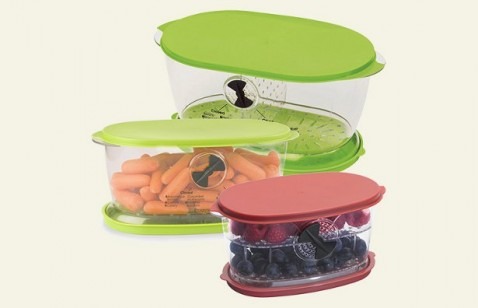
Some produce picks, including lettuce, greens, and berries, always tend to spoil before others. Reclaim all that hard-to-preserve produce with smart storage solutions that can extend shelf-life by up to two weeks.
These handy Fruit and Vegetable Keepers from Progressive International feature an adjustable vent that allows for air regulation to retain optimal produce freshness. Keep air vents open for produce like asparagus, carrots, berries, and mushrooms, and close them up for lettuce, peas, greens, grapes, and peppers.
A water reservoir in the base of the containers keeps produce moist, and the whole thing doubles as a colander for easy washing and storing.
DIY Alternative: Storing each produce pick in accordance with its needs is the best way to ensure maximum freshness. Check out this produce storage guide Vegetarian Times to find out how to properly store all your fruits and veggies for better flavor and a longer shelf-life.
10. Vacuum Sealer
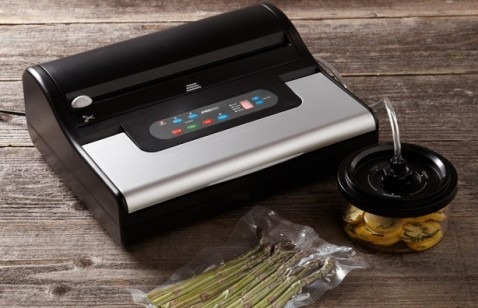
Vacuum sealers are immeasurably handy for keeping food fresh. With the touch of a button, these nifty machines seal food inside an airtight vacuum bag or canister for storing in the refrigerator, freezer, or pantry.
So, you can use a vacuum sealer to store leftovers from last night’s dinner in the fridge, seal prepared sauces for pantry storage, or keep in-season produce in the freezer for months to come.
Keep in mind that vacuum sealers can be a bit pricier than the other gadgets on our list (most range from $100 to $300). But many home cooks say the food-saving benefits are well worth the investment.
Check out these vacuum sealer models from Food Saver and Nesco to see if one suits your needs and budget.
DIY Alternative: It’s tough to replicate the food-saving effects of a vacuum sealer. But if you’re looking to achieve similar results without buying new (or spending extra cash), check out this creative DIY method from Kitchn, which helps you seal up your food with a straw and a plastic freezer bag.
Feature image Flickr/Michelle Tribe. Originally published on March 4, 2016, this article was updated in March 2020.
You Might Also Like…
10 Creative Ways To Help Keep Food Fresh
April 29, 2020How To Practice Social But Not Emotional Distancing
April 28, 2020We Earthlings: Our Warming Planet Earth
April 28, 2020The post 10 Creative Ways To Help Keep Food Fresh appeared first on Earth911.com.

